Nazi collaborator monuments in the United Kingdom
In Bradford, a plaque celebrates the Anti-Bolshevik Bloc of Nations, the brainchild of war criminal Alfred Rosenberg
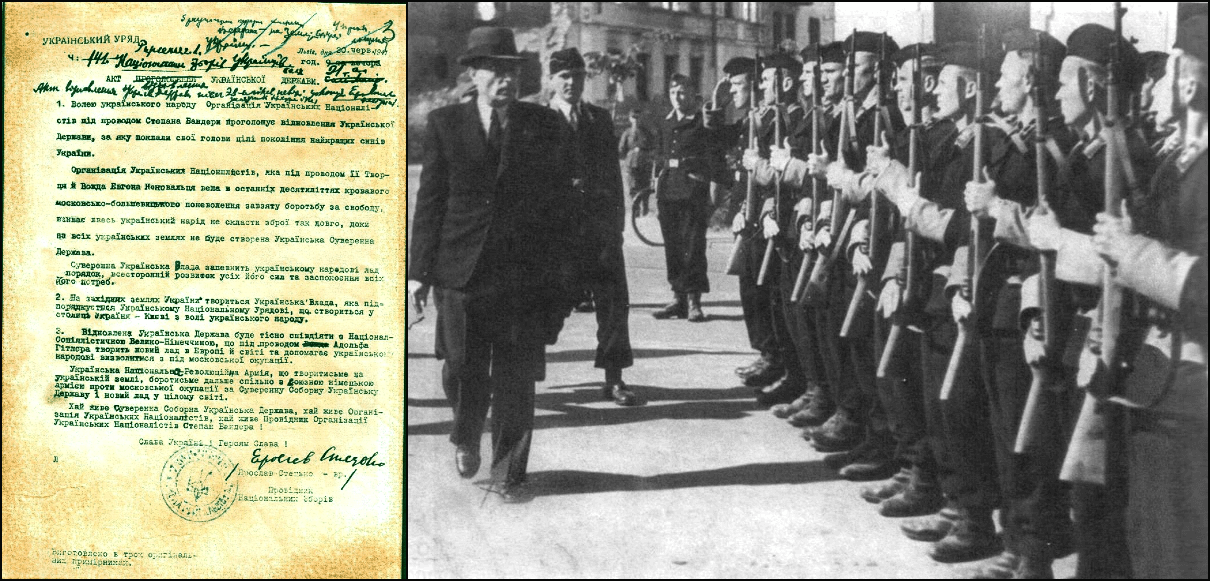
Left: Yaroslav Stetsko’s signature on the June 30, 1941 proclamation of the establishment of the Nazi collaborationist government by the Stepan Bandera faction of the Organization of Ukrainian Nationalists (OUN-B); the government was headed by Stetsko (Wikimedia Commons). Right: Radasłaŭ Astroŭski inspecting Belarusian auxiliary police (Wikimedia Commons). Image by Forward collage
This list is part of an ongoing investigative project the Forward first published in January 2021 documenting hundreds of monuments around the world to people involved in the Holocaust. We are continuing to update each country’s list; if you know of any not included here, or of statues that have been removed or streets renamed, please email [email protected], subject line: Nazi monument project.
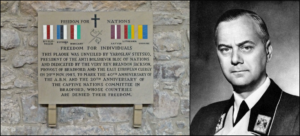
Bradford — This noble-sounding “Freedom for Nations” plaque celebrates the 40th anniversary of the Anti-Bolshevik Bloc of Nations (ABN), ostensibly a group representing Eastern European nations imprisoned by the USSR. In reality, the ABN was a one-stop shop for ex-Nazi collaborators and Holocaust perpetrators who had successfully fled to the West at the end of WWII. These collaborators rebranded themselves as anti-Communist “freedom fighters;” they were welcomed by Western governments who sought to use them to stir up anti-Soviet rebellions in Eastern Europe.
The ABN was originally created by the Nazis in 1943. It was the brainchild of Alfred Rosenberg, above right, a seminal figure in the Third Reich who was hanged for crimes against humanity at Nuremberg. By the time the ABN was taken over by the U.S., it was teeming with individuals directly involved in the Holocaust.
The Bradford plaque notes it was installed by ABN President Yaroslav Stetsko (1912–1986), a leader of the Stepan Bandera faction of the Organization of Ukrainian Nationalists (OUN-B). In 1941, Stetsko headed the OUN-B’s Nazi-collaborationist government which welcomed the German invasion of Ukraine and declared allegiance to Hitler. He was a genocidal antisemite who had written “I insist on the extermination of the Jews and the need to adapt German methods of exterminating Jews in Ukraine.”
Five days prior to the Nazi invasion, Stetsko assured Bandera: “We will organize a Ukrainian militia that will help us to remove the Jews.” The OUN came through, instigating and carrying out pogroms that murdered thousands of Jews. See the Germany and Ukraine sections for more on Stetsko.
Another ABN officer was Ferdinand Ďurčanský (1906–1974), who served as a minister in the Nazi puppet government of Slovakia and was deemed complicit in the death of Jews by the United Nations. Radasłaŭ Astroŭski (1887 – 1976), who led Belarusia’s Nazi puppet administration and organized local auxiliary police that participated in the Holocaust, was also an ABN officer. See the Slovakia and U.S. sections for more. See The Nation’s interview with journalist Russ Bellant, who wrote the indispensable study of the ABN.
Below left, Stetsko’s signature on the 1941 OUN-B proclamation which pledges to “work closely” with Nazi Germany. Below right, Astroŭski inspecting Belarusian auxiliary police units.
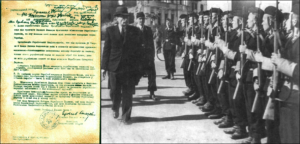
***

Derby (entry added August 2023) – The Saint Michael the Archangel Ukrainian Greek Catholic Church contains two memorial plaques to the 14th Waffen Grenadier Division of the SS (1st Galician) aka SS Galichina.
SS Galichina was a Ukrainian formation in the Waffen-SS, the military branch of the SS, which itself was a military wing of the Nazi Party. It was deemed important enough to be visited and encouraged by SS leader Heinrich Himmler, one of the main organizers of the Holocaust. Among war crimes committed by SS Galichina is the Huta Pieniacka massacre, when its soldiers burned 500–1,000 Polish villagers alive.
The plaque at top left commemorates the 60th anniversary of the division’s creation; the plaque at bottom left is in memory of SS Galichina soldiers killed at the 1944 Battle of Brody, where much of the unit was destroyed.
Above right, a parade celebrating SS Galichina in Stanislaviv (now Ivano-Frankivsk), 1943. Below right, an SS Galichina recruitment poster with Hitler’s quote from Mein Kampf: “Whoever wants to live must fight, and whoever doesn’t want to fight in this world of permanent struggle — he doesn’t deserve the right to live. Adolf Hitler.” Underneath is “SS Galichina is going to battle!”

***
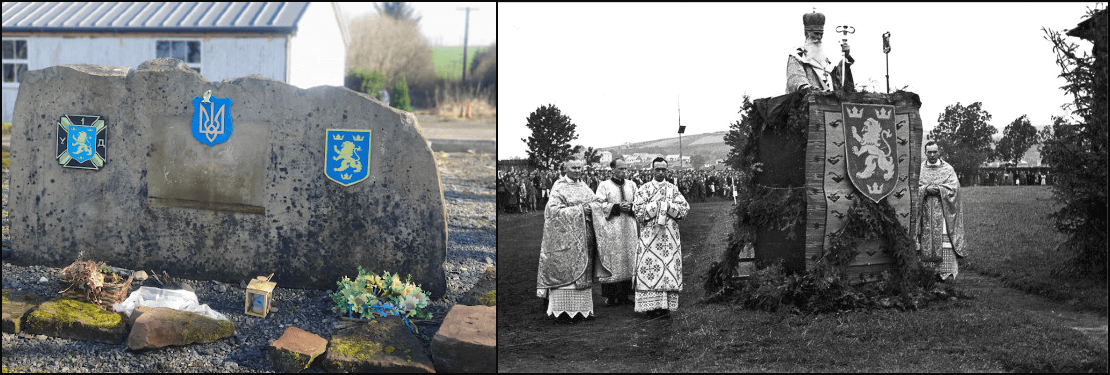
Lockerbie (entry added August 2023) – A memorial to SS Galichina outside a makeshift chapel constructed out of a shack on the site of a former prisoner-of-war camp that once housed SS Galichina soldiers. The Ukrainian SS POWs were moved to Britain in 1947; they built the chapel shortly after their arrival.
The vast majority of the 8,000-plus SS Galichina prisoners who were sent to Britain were eventually freed and allowed to settle in the U.K.
The chapel has seen a renewed interest when it began to be used as a collection hub for humanitarian aid for Ukraine after Russia’s 2022 full-scale invasion of the country. Coverage of this often omits or glosses over the fact the chapel was built by Third Reich soldiers. In 2022, the chapel received a grant for restoration.
Above right, mass performed by Josaphat Kotsylovsky, one of the priests assigned to SS Galichina, 1943.
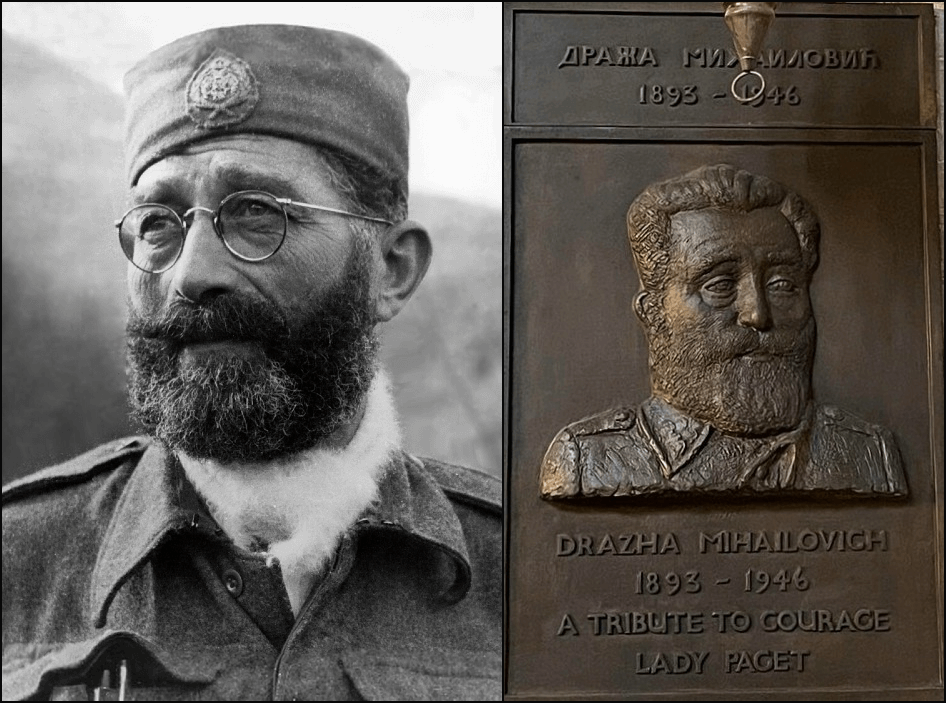
London (entry added June 2025) – A bas-relief of Dragoljub “Draža” Mihailović (1893–1946) in the Serbian Orthodox Church of Saint Sava in the Notting Hill neighborhood of London. Mihailović commanded the Chetniks, a royalist militia which had collaborated with the Nazis and their Serbian puppets. The Chetniks carried out ethnic cleansing of Croats and Bosniaks; according to Yad Vashem, they also killed Jews and turned them over to the Nazis.
Toward the end of the war, Mihailović switched sides, joining with the Allies and using his troops to rescue over 400 American airmen shot down in enemy territory. This earned him a posthumous Legion of Merit award from Harry Truman. See Reuters and Radio Free Europe reports on his rehabilitation and coverage in Radio Slobodna Evropa (Radio Free Europe’s Balkan branch; Google translation here.)
For more Chetnik statues, see the Serbia, Bosnia and Herzegovina, U.S., Australia and Canada sections.























